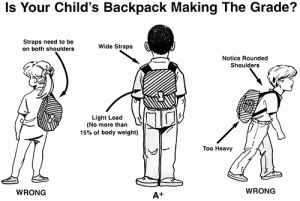Backpack Safety Tips
Backpack Safety Tips
With school starting back up today, backpacks are a commonly overlooked issue; therefore, we are providing simple to follow backpack safety tips. Too often, school bags and backpacks are purchased because of the designer and style. Rarely, are school bags and backpacks are purchased because of the designer and style. Rarely, are backpacks purchased with the safety of the child as a priority. Backpacks have the potential of creating abnormal stresses on the body and potentially causing injury.
When purchasing a backpack: 
1) Check the size: the backpack should sit on your child’s torso 1-2 inches below the shoulders and down to the small of the back. It should never “sag” towards the buttocks.
2) Check the fit: when wearing the backpack (equipped with books, etc) your child should be able to
stand upright without a change in their normal posture. The child should not have to lean forward
and round their shoulders nor should they arch their back to carry the load.
3) Check the straps: the shoulder straps should be wide and padded to reduce the compression on the
vulnerable nerves and arteries. They should be adjusted to allow free movement of the arms and the
ease of removing and putting on of the backpack. Also, look for hip and chest belts. These are
important when carrying heavier loads to reduce the pressure on the back and shoulders and
important for the older children/adolescents.
4) Check the material: Padding on the back reduces pressure and enhances comfort. Padding can also
reduce unwarranted sharp or pointed objects from “jabbing” your child in the back. Look for
materials (zippers, clasps, canvas, etc) that will endure the rugged use a child puts them through.
5) Check the color/design: While color in itself is not a safety issue, reflective material does enhance
the visibility of your child in the mornings. Also note any distinguishing marks or designs on the
backpack in case it is lost or stolen.
When wearing a backpack:
1) Always use both straps: This distributes the load more symmetrically over your child’s back and
enhances posture.
2) Keep the load to less than 15% of their total body weight. Excessive weight creates abnormal
postures, fatigues the muscles, and can compress the nerves.
3) Observe for signs of pain, change in postures, complaints of tingling or numbness in the arms, or
redness on the shoulders and back.
Following these simple tips can prevent further issues with your child. If you have further questions, don’t hesitate to call PHYSIO today!
 PHYSIO Physical Therapy and Wellness Asheville
PHYSIO Physical Therapy and Wellness Asheville
660 Merrimon Ave, Ste C
Asheville, NC 28804
(828) 348-1780

